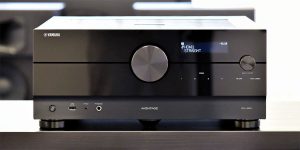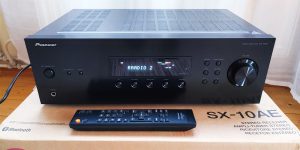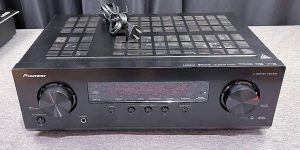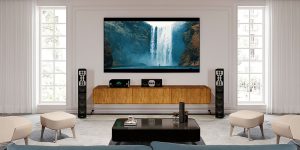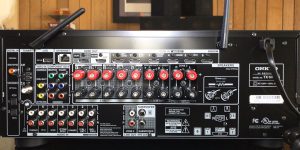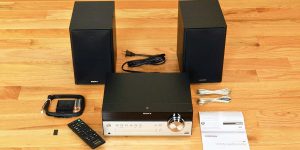There’s probably no need to explain the importance of choosing a new AV receiver for your home theater. Whether you are buying it for the first time or upgrading your system, this choice is not always the easiest decision.
In this article, I offer you a rating of the best Onkyo receivers because the Japanese brand has been on the market for more than 75 years and produces products that meet the needs of modern users, following the main criteria – sound quality and design while maintaining affordability. There are 5 models of different configurations and functionality waiting for you, so sit back and get ready for interesting research.
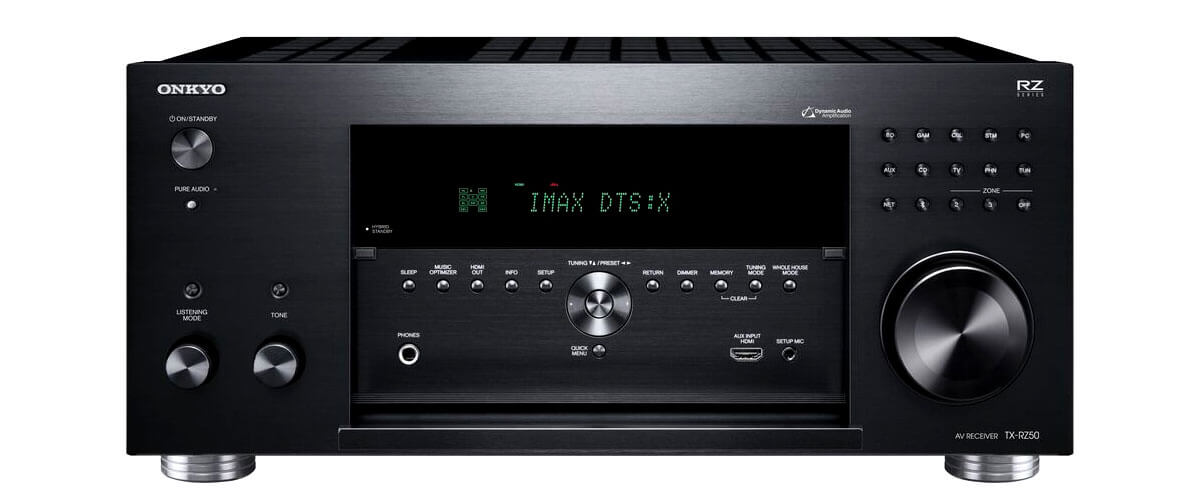
Onkyo AV receivers comparison table
| Name | Channels | Power output | HDMI in/out | Bluetooth/Wi-Fi | Review |
|---|---|---|---|---|---|
| Onkyo TX-RZ50 best overall | 9.2 | 120 W/8 ohms | 7/2 | yes/yes | Review |
| Onkyo TX-NR7100 also great | 9.2 | 100 W/8 ohms | 7/2 | yes/yes | Review |
| Onkyo TX-NR6100 under $1000 | 7.2 | 100 W/8 ohms | 6/2 | yes/yes | Review |
| Onkyo TX-SR494 budget | 7.2 | 80 W/8 ohms | 4/1 | yes/no | Review |
What Onkyo receivers did we test?
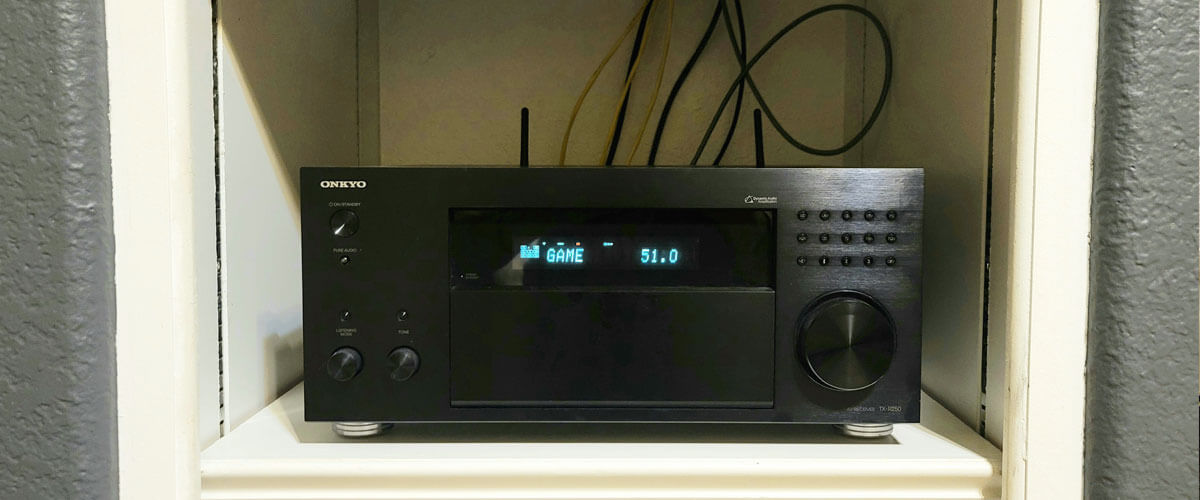
When I prepare lists of top receivers, I try to be guided not only by my personal impressions from testing. I also considered customer reviews from various retail sites and the opinion of other users and experts from popular audio forums so that the rating of current models for 2025 was as objective as possible.
The upcoming Onkyo receivers review for a combination of technical reasons and impressions from testing, although I tried them, did not include models Onkyo TX-NR797, Onkyo TX-RZ840, and Onkyo TX-SR393. However, they are also pretty good.
Our criteria for choosing the best Onkyo AVR
One more thing is worth mentioning before we get to the review itself. Namely, the criteria on which the choice was based:
- listening experience.
- availability of necessary built-in features (support for modern video technologies, surround sound formats, Bluetooth, Ethernet/Wi-Fi/streaming services, etc.).
- a sufficient number of input and output connections.
- price.
I have tried to select optimal Onkyo AVR models for different purposes and tasks in different price segments.
Best Onkyo AV receiver reviews
Onkyo TX-RZ50 – best overall

And the leader among the winners of my chart is Onkyo TX-RZ50. The 9.2-channel model is the most expensive of all presented, but if you compare this receiver with similar ones in the lines of other brands, you will realize that the price is extremely reasonable. It impresses with its features.
The first thing that will catch your eye is the expandability of up to 11.2 channels. It’s hard to wish for more. At the same time, the TX-RZ50’s power output meets such standards and amounts to 120W (8 ohm, 20Hz – 20kHz, 0.08% THD, 2 ch). Believe me, you’ll be able to experience the sound while watching.
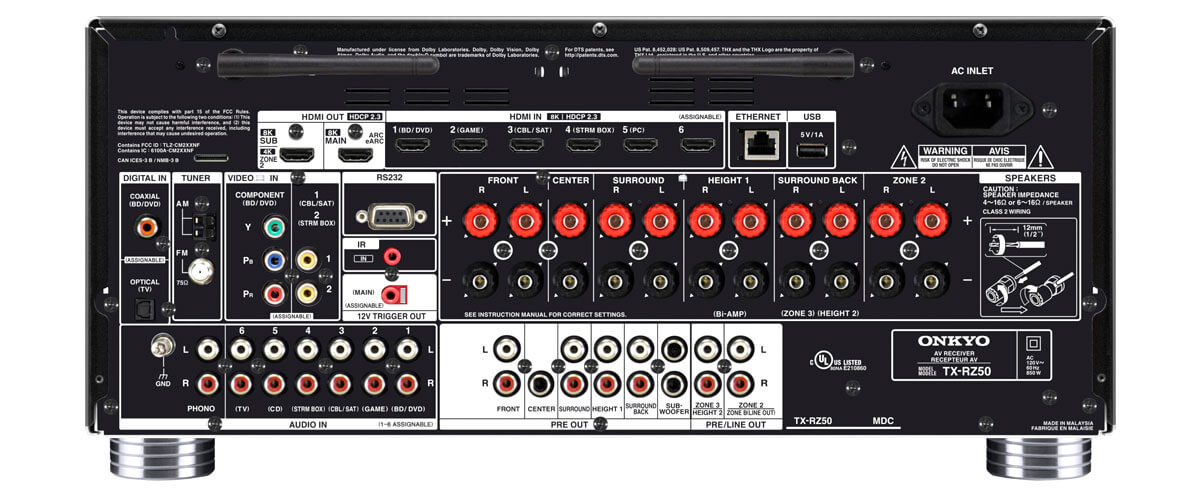
Being released in 2021, the AV receiver is certainly up to modern standards. Its HDMI (6/2) is version 2.1 and supports eARC, CEC, and HDCP 2.3 features, which means support for HDR video at 8K/60Hz (Zone 1 only) and 4K/120Hz (Zone 1 and 2). And as the previous sentence makes clear, video can be streamed to 2 zones and audio to 3 (AirPlay 2 and Sonos). Excellent performance for homeowners and large families.
Sure, the model has Wi-Fi (DTS Play-Fi) and Bluetooth (aptX HD) advanced versions, and it supports streaming services and voice assistants (really great, by the way), but it wasn’t without some disappointment. I was not impressed with the work with applications; everything is too simplistic and not much easier to manage.
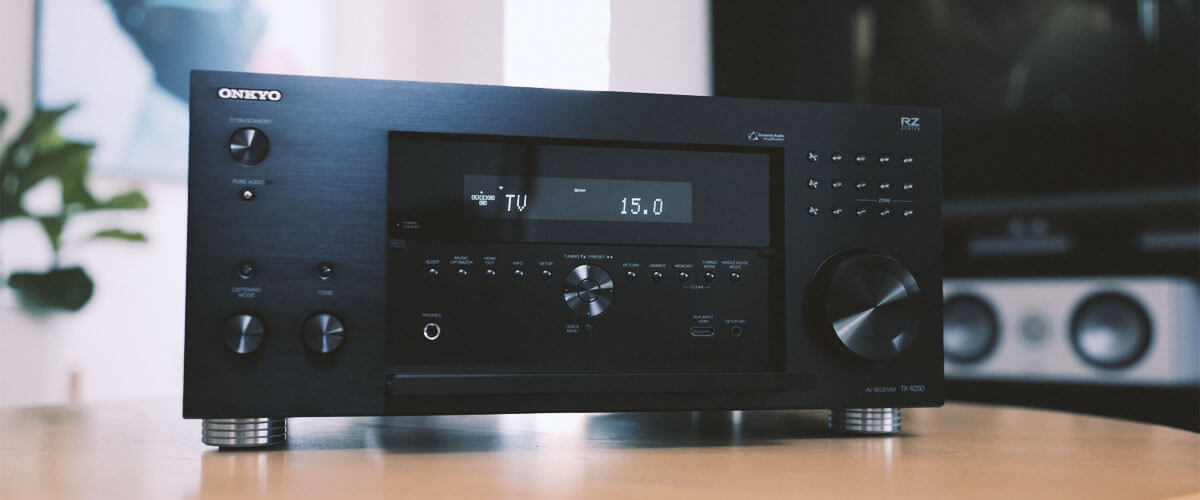
My movie-watching tests still left no trace of doubt. The Onkyo TX-RZ50 deserves its top spot in this ranking. Support for Dolby Atmos, DTS:X, and IMAX Enhanced immersive audio formats showed excellent dialog and frequency detail results. But the Dirac Live Room Correction is, as usual, overly obfuscated. Automatically adjusting the system, you’ll get unconventionally low bass. This can be solved manually, of course, but if we are talking about a high-end device, it does not meet the application in the calibration area. In addition, the receiver is THX certified.
The Onkyo TX-RZ50 earns the title of best Onkyo receiver for its market-competitive price and versatility. Essentially, you get access to all modern audio and video formats and additional chips and can upgrade the system over time, making it durable and a good investment.
Key specs
- Channels: 9.2.
- Power output: 120W/8 Ohm, 250W/6 Ohm.
- HDMI inputs/outputs: 7/2.
- Video functions: 8K/60Hz, 4K/120Hz, 4K/60Hz pass-through, video upconversion (up to 1080p and 8K) for analog and HDMI sources.
- Bluetooth/Wi-Fi: yes/yes.
- Streaming services: AirPlay2, Deezer, Tidal, Pandora, Spotify, Amazon Music HD, TuneIn.
- Supports: HDMI ARC, HDMI eARC, HDMI CEC, HDCP2.3, HDR10, HDR10+, Dolby Vision.
- Surround sound: DTS HD Master, DTS Neural:X, Dolby TrueHD, Dolby Surround, Dolby Digital Plus, Dolby Atmos Height Virtualization, Dolby Atmos, IMAX Enhanced.
Pros
- High power compared to other models on the list.
- Expandable to an 11.2 configuration.
- Ability to stream video to 2 zones.
- Advanced versions of Wi-Fi (DTS Play-Fi) and Bluetooth (aptX HD) showed excellent performance.
Cons
- Working with apps leaves a lot to be desired.
- There may be difficulties with setup; the process is somewhat complicated.
Onkyo TX-NR7100 – also great
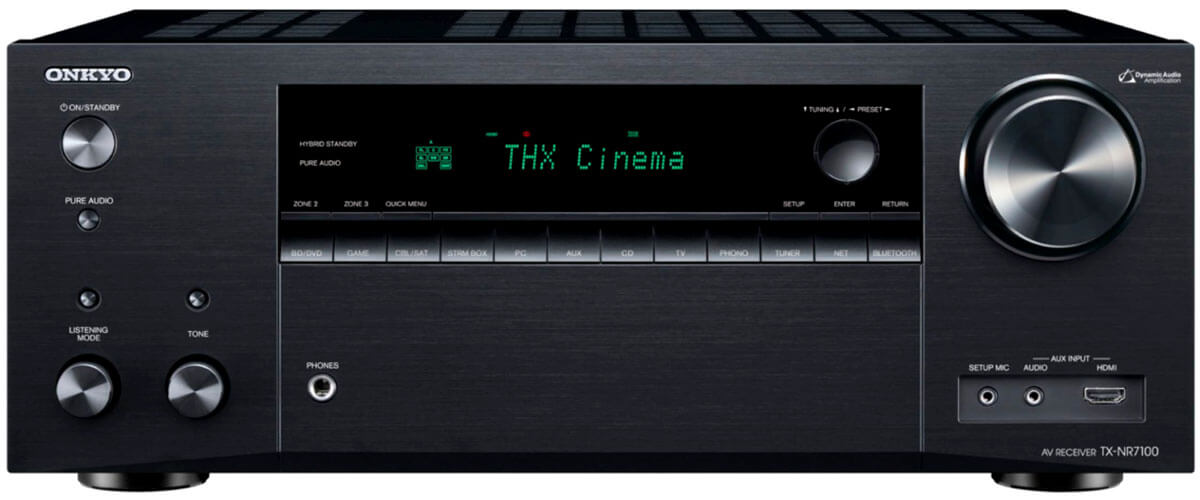
The second place of my selection goes to the Onkyo TX-NR7100 model, as it has an ideal price/quality combination out of all the ones presented in the rating. And comparing this receiver with the previous one, it’s easy to understand why. Moreover, the TX-NR7100 is also a 9.2-channel AVR, but unlike the TX-RZ50, its configuration cannot be expanded.
It’s also inferior in power, providing only 100W per channel (8 ohm, 20Hz – 20kHz, 0.08% THD, 2 ch), though, in my opinion, that’s still quite enough for most of us. Also, audio broadcasting is available for several zones, but with restrictions (8K for Zone 1, 4K for Zone 2, and the third zone broadcasts analog and Net sources only). It is required to be sure to disable the second zone in the settings if you only use the main zone; it’s a bit annoying. I was in for a positive surprise in the connectivity area, as the TX-NR7100 has one input more (7/2) than the TX-RZ50. But I noted that sometimes there are problems with the synchronization of HDMI signals (there are delays between switching sources).
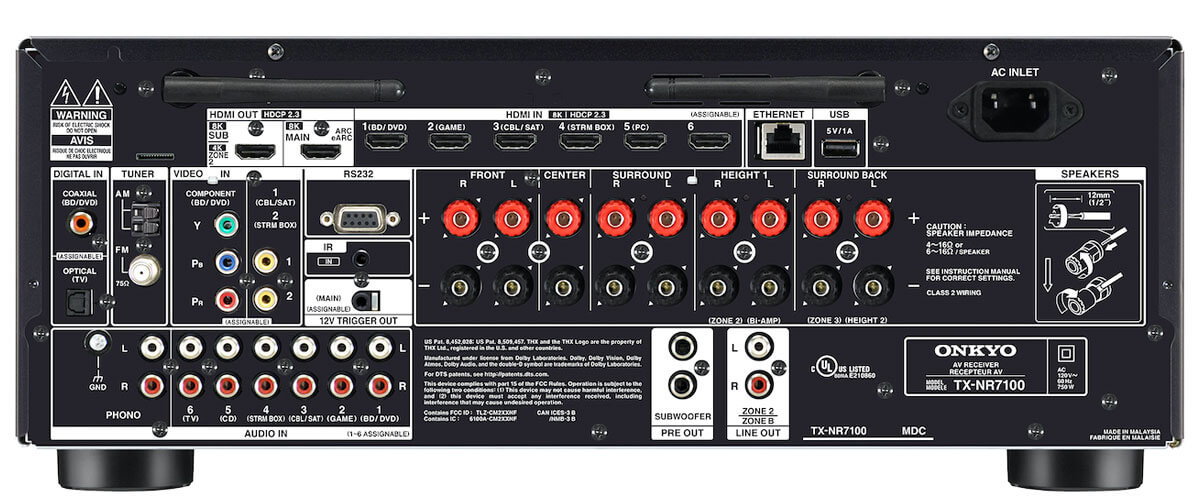
The Wi-Fi and Bluetooth wireless connections are also advanced, working very well, but they don’t support voice assistants. However, purchasing a separate device to work with Google or Alexa is possible.
The TX-NR7100 supports immersive Dolby Atmos and DTS:X formats you can build 5.2.4 or 7.2.2 configurations, and it features THX Certified and IMAX Enhanced technologies. That’s why it’s testing also got me excited. Classic Onkyo with quality sound, even at a fairly high volume, perfectly coped with Mission: Impossible – Fallout, which is full of action scenes.
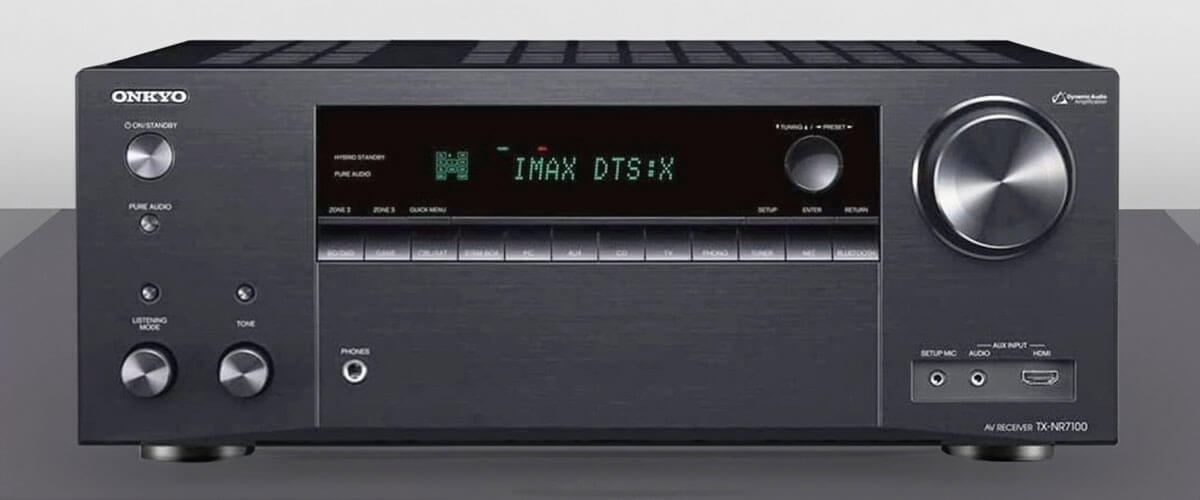
Already in one of the initial scenes of flying in the clouds and being struck by lightning, I felt an adrenaline rush from the sound around me; it was like I was flying along with Ethan Hunt. And I would end my pathos passage here if I didn’t want to say a few words about AccuEQ Advance with AccuReflex. For me, it surpasses Dirac in its simplicity and convenience. Another plus to the piggy bank of this model.
Onkyo TX-NR7100 is an excellent home theater system, only slightly inferior to the chart leader. The receiver combines pure sound, classic brand quality, and extremely reasonable price, forming a great middle-class balance.
Key specs
- Channels: 9.2.
- Power output: 100W/8 Ohm.
- HDMI inputs/outputs: 7/2.
- Video functions: 8K/60Hz, 4K/120Hz, 4K/60Hz pass-through, video upconversion (up to 1080p and 8K) for analog and HDMI sources.
- Bluetooth/Wi-Fi: yes/yes.
- Streaming services: AirPlay2, Deezer, Tidal, Pandora, Spotify, Amazon Music HD, TuneIn.
- Supports: HDMI ARC, HDMI eARC, HDMI CEC, HDCP2.3, HDR10, HDR10+, Dolby Vision.
- Surround sound: DTS HD Master, DTS Neural:X, Dolby TrueHD, Dolby Surround, Dolby Digital Plus, Dolby Atmos Height Virtualization, Dolby Atmos, IMAX Enhanced.
Pros
- The optimal price/quality combination on the entire list.
- More HDMI input ports than the Onkyo TX-NR7100.
- The AccuEQ Advance calibration system is very convenient.
Cons
- The main zone doesn’t work unless you disable Zone 2 in the settings when not using it.
- Sometimes there are delays when changing HDMI signals.
Onkyo TX-NR6100 – under $1000
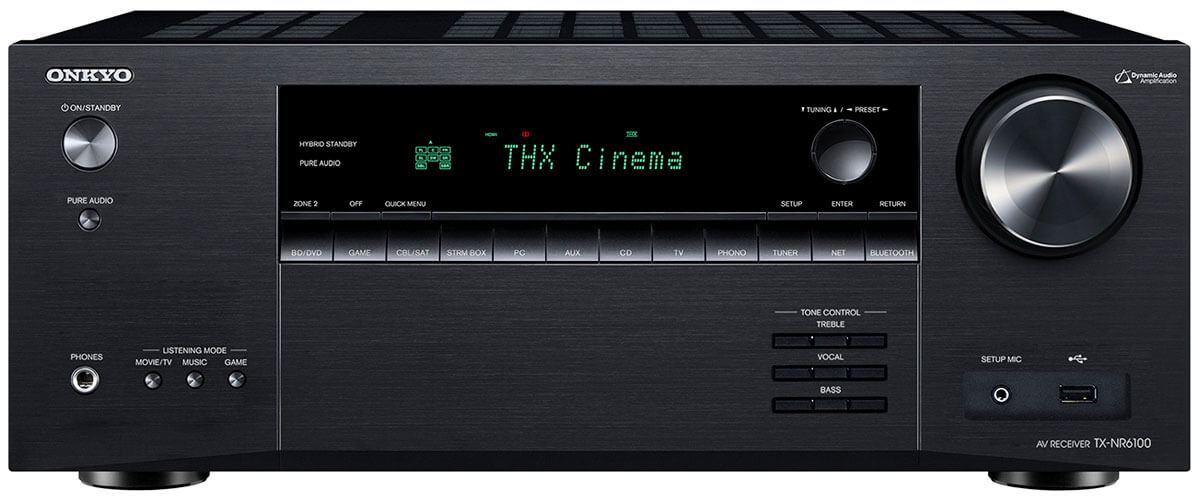
Moving on to less expensive models, I will say right away that we will talk about 7 channels, but you will save significantly on the purchase. For example, Onkyo TX-NR6100, released in 2021, simply amazes with its functionality, which can quite compete with models of high rank.
The power it delivers is 100 watts per channel (8 ohms, 20 Hz – 20 kHz, 0.08% THD, 2 ch), identical to the Onkyo TX-NR7100. Yes, and the quantity and quality of HDMI are on par with the leader Onkyo TX-RZ50 (version 2.1 supports 8K video and 4K upscaling on 3 out of 6 ports). But it is important to know that this AVR does not work with all TVs (for example, it is not compatible with Nvidia G-Sync), and during testing, games (because it has VRR and ALLM functions) showed mediocre performance.
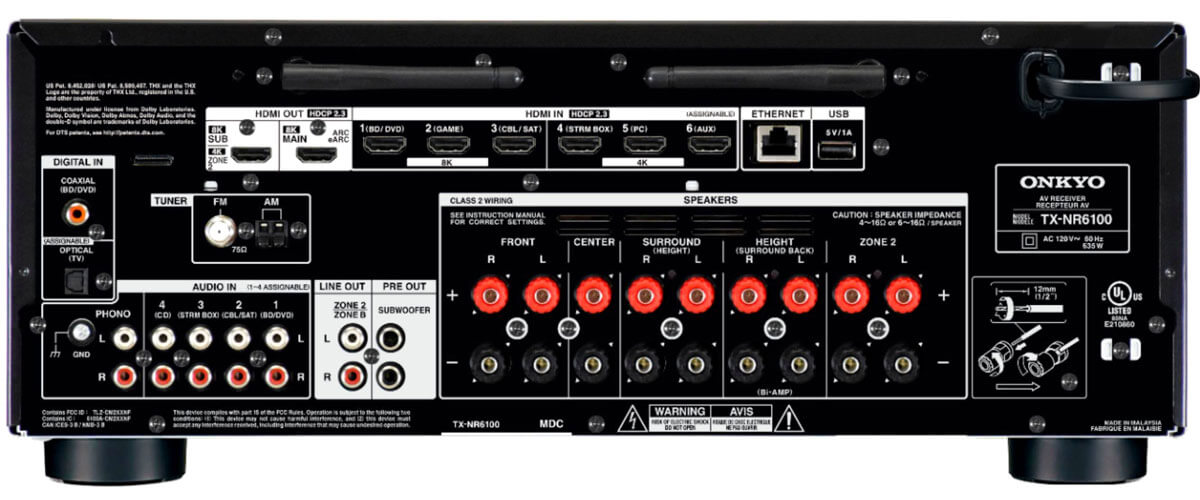
I was also impressed with the DTS Play-Fi and two-way Bluetooth (also like the Onkyo TX-NR7100). Listening to streaming services went without problems and left me in a great mood. But, for example, the provided work with Sonos and Alexa Voice Assistant will be available to you only after purchasing special equipment. Well, the trade-offs were to be expected.
Installation and calibration is so easy that it will not cause doubts even for novice users. But the main thing is that this model also supports Dolby Atmos and DTS: X. Nothing special against the background of previous competitors if it were not for the receiver’s price.
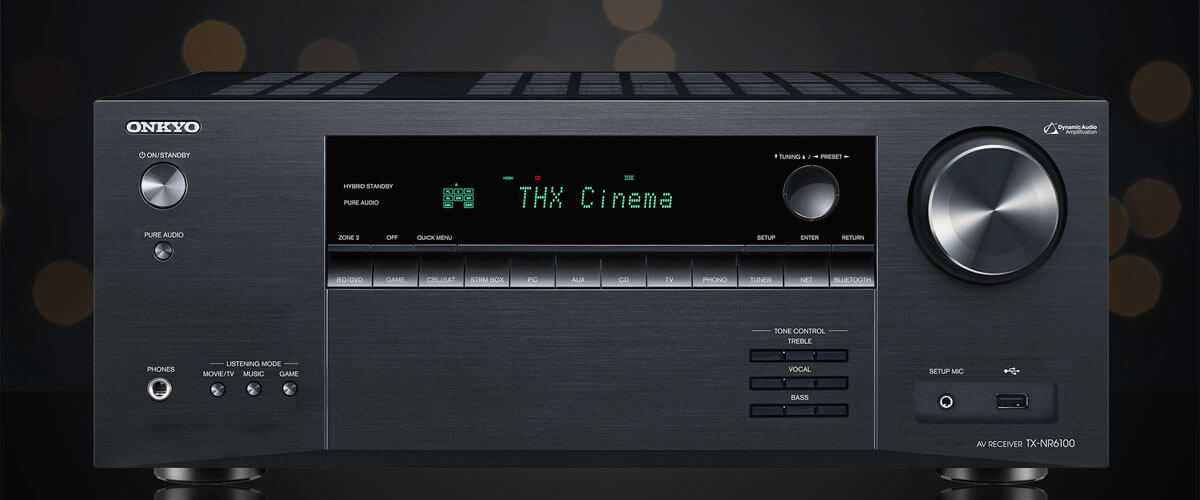
The TX-NR6100 sound quality didn’t surprise me, but it didn’t disappoint me either. For its level, the receiver really copes with its task perfectly, although it is somewhat simpler than expensive models. Nevertheless, dialogs are listened to clearly, and the overall soundstage is not mixed. But for this, credit should be given to THX CERTIFIED, which does not allow you to change the original signal format.
Well, in conclusion, we can say that the Onkyo TX-NR6100 is a modern receiver and will serve as a great alternative to replace more expensive models. This is truly the best Onkyo AV receiver under $1000 for those who want advanced technology at a lower price.
Key specs
- Channels: 7.2.
- Power output: 100W/8 Ohm, 210W/6 Ohm.
- HDMI inputs/outputs: 6/2.
- Video functions: 8K/60Hz, 4K/120Hz, 4K/60Hz pass-through, 1080p to 8K/4K video upscaling via HDM.
- Bluetooth/Wi-Fi: yes/yes.
- Streaming services: AirPlay2, Deezer, Tidal, Pandora, Spotify, Amazon Music HD, TuneIn.
- Supports: HDMI ARC, HDMI eARC, HDMI CEC, HDCP2.3, HDR10, HDR10+, Dolby Vision.
- Surround sound: DTS HD Master, DTS Neural:X, Dolby TrueHD, Dolby Surround, Dolby Digital Plus, Dolby Atmos Height Virtualization, Dolby Atmos, IMAX Enhanced.
Pros
- Functionally, it is very similar to the more expensive models.
- The receiver showed high-quality wireless performance.
- Easy installation and calibration are suitable even for beginners.
Cons
- For Sonos and Alexa, you need to purchase a special port separately.
- Not compatible with some TVs.
Onkyo TX-SR494 – budget
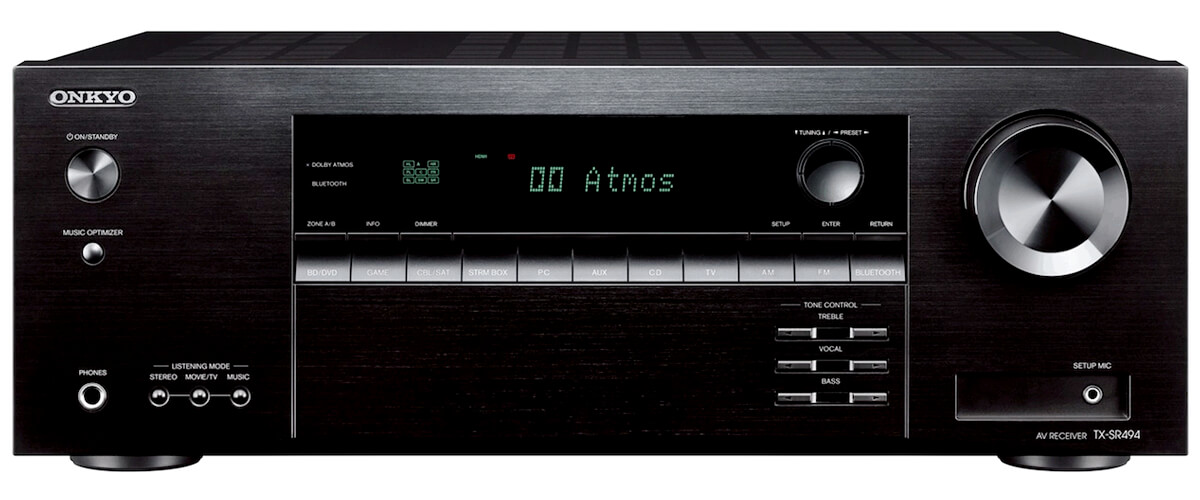
When it comes to budget receivers, we think we have a lot to lose by opting for them. But not in the case of Onkyo TX-SR494, I assure you. This surround sound receiver can please you to the fullest.
HDMI ports are few (4/1) but support HDCP 2.3 and CEC. 4K video is only available at a 60Hz frame rate (most content today is available at this resolution), but you can also upscale to lower resolutions (up to 4K). True, you need to take care of a special cable, as our pest doesn’t want to work with regular ones.
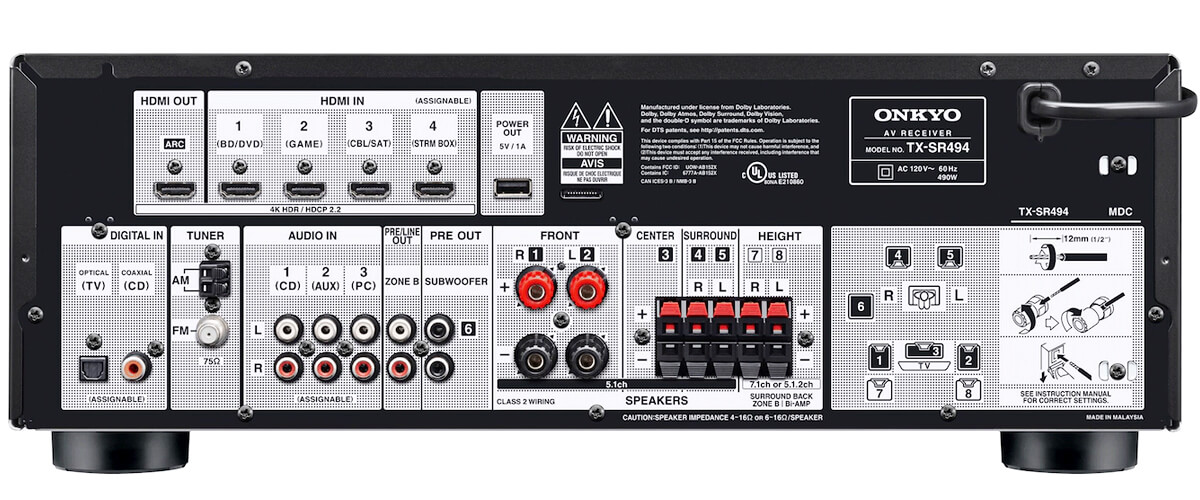
The power output of 80 watts (8 ohms, 20-20 kHz, 0.08%, 2ch) is within the limits available for 7.2-channel receivers. But what I like the most is that along with support for Dolby Atmos and DTS:X (5.2.2), you don’t have to use height speakers at all, as the receiver also has support for Dolby Atmos Height Virtualizer and DTS Virtual:X. I think these immersive formats are ideal for small rooms (which the Onkyo TX-SR494 is perfect for), where every meter counts and many objects can affect the acoustics.
This model doesn’t have Wi-Fi, but even the available Bluetooth doesn’t cope with streaming services and makes nightmarish noises. There’s also no Multi-Room feature. So if you were counting on filling your house with music – oops.
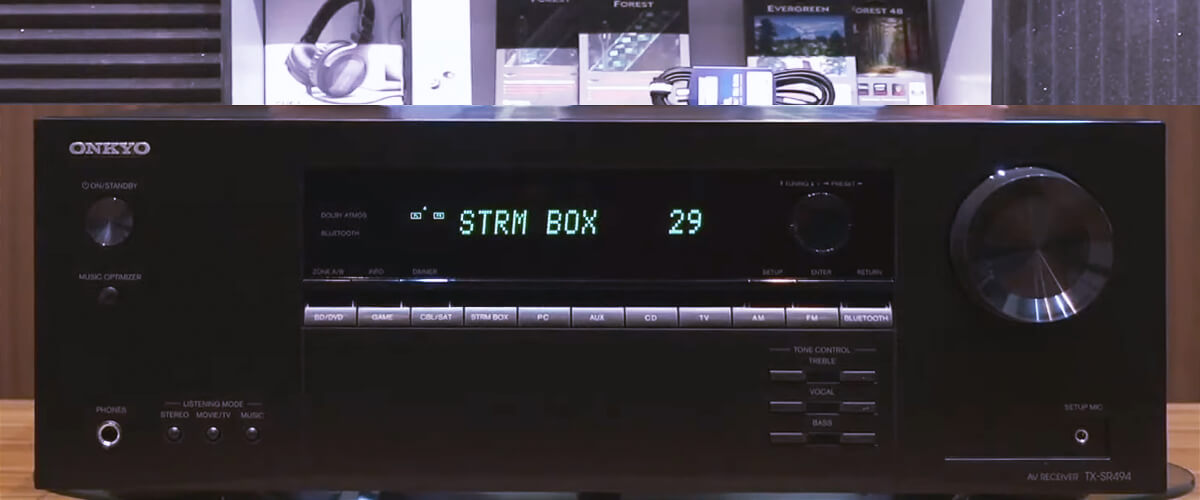
The AccuEQ calibration also perplexed me, as the sound was flat and muddy after auto-tuning. Manual intervention improves the picture considerably, and you can finally realize that the sound is surprisingly good for such a simple model. Moreover, I brought the dialog reproduction to quite a high level with the voice adjustment function.
Onkyo TX-SR494 will not become a receiver for all occasions, but it will definitely suit those who want to improve their viewing experience with most existing content today. Despite being designed in 2019, the model is relevant today and supports high-quality surround sound formats.
Key specs
- Channels: 7.2.
- Power output: 80W/8 Ohm, 160W/6 Ohm.
- HDMI inputs/outputs: 4/1.
- Video functions: 4K/60Hz pass-through, 1080p Full HD to 4K Ultra HD upscaling over HDMI.
- Bluetooth/Wi-Fi: yes/no.
- Streaming services: has not.
- Supports: HDMI ARC, HDCP2.2, HDR10, Dolby Vision.
- Surround sound: DTS HD Master, DTS Neural:X, DTS:X, Dolby TrueHD, Dolby Surround, Dolby Atmos Height Virtualization, Dolby Atmos.
Pros
- It works with Dolby Atmos Height Virtualizer and DTS Virtual:X, which saves space and money (fewer speakers).
- The voice tuning feature has greatly improved the sound tuning result.
Cons
- 4K doesn’t work with regular HDMI cables.
- There’s no Wi-Fi, and Bluetooth doesn’t handle streaming services well.
- You’ll have to adjust the sound manually to achieve good sound.
Onkyo TX-NR6050
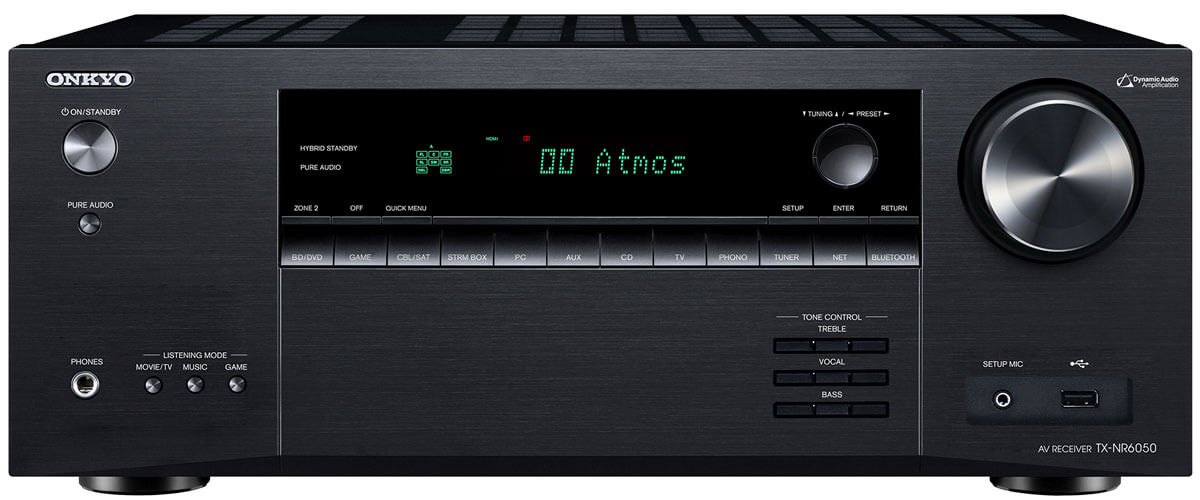
If you liked the Onkyo TX-NR6100 receiver but are not ready to pay a little more, I present you the excellent (for its category) Onkyo TX-NR6050. You have almost nothing to lose but a couple of extra hundred bucks in your pocket.
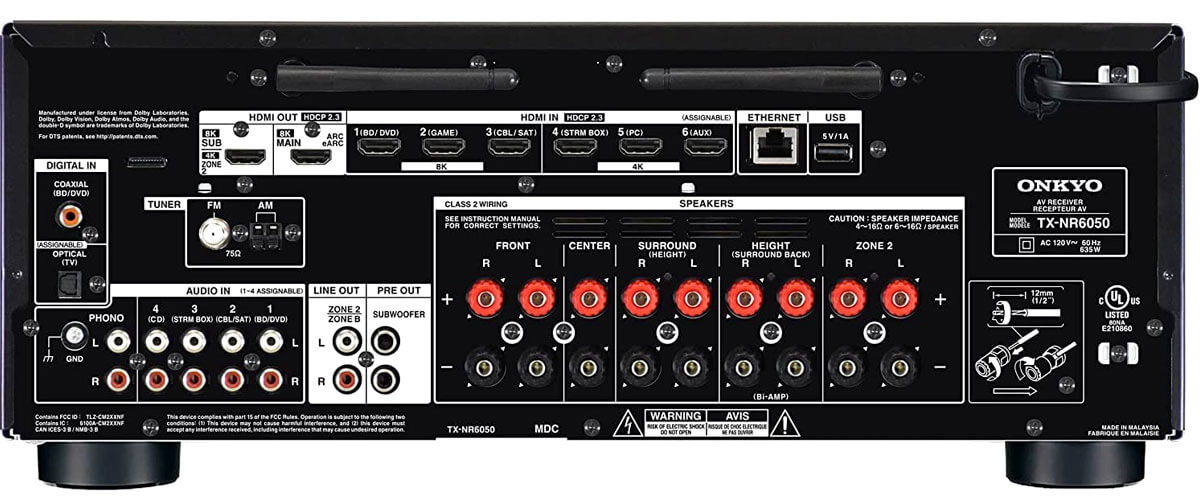
So, this is the latest AV receiver from my list, a representative of 2022 models. And if we go over similar features to TX-NR6100, it has 7.2 channels, the same number of HDMI ports with HDCP 2.3, 8K/60 Hz, 4K/120 Hz, and HDR support, works with streaming services (there are built-in) and voice assistants, audio for 2 zones, and advanced versions of Bluetooth and Wi-Fi. I noted the extremely stable operation of almost every option listed, which is terrific for the TX-NR6050 cost.
There were some slight source delays via HDMI, but I don’t classify that as a drawback, as it didn’t freak me out, and for a device like this, it’s just normal. It even has a phono input for a turntable. So in this part, I can conclude that the model will be a great option for those who want to have advanced audio system features.
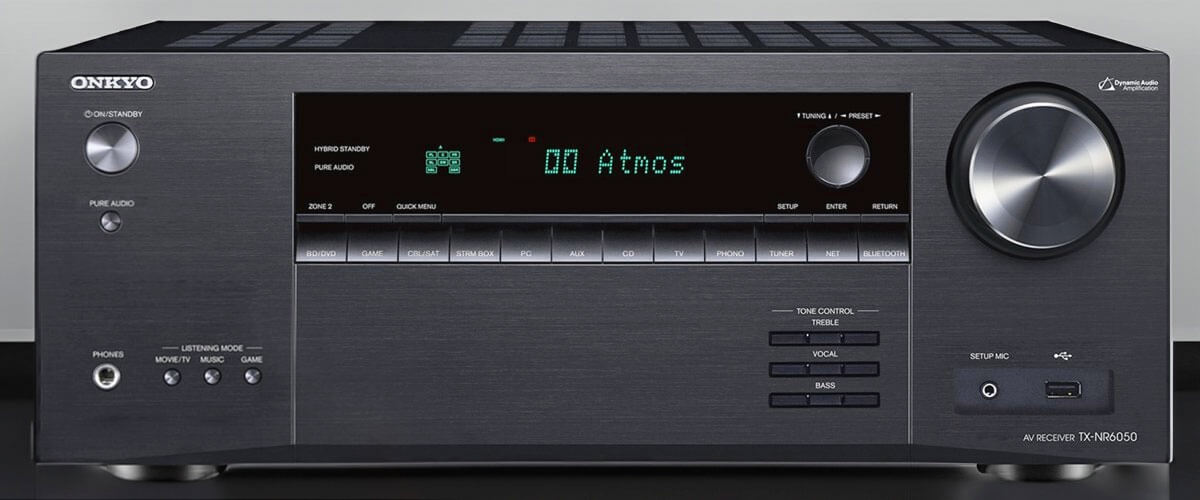
The Onkyo TX-NR6050 is inferior to the TX-NR6100 in power, providing 90 watts per channel (8 ohms, 20 Hz – 20 kHz, 0.08% THD, 2 ch) rather than 100W. And it’s also not THX CERTIFIED, which is audible when using Dolby Atmos and DTS:X surround sound formats. Nevertheless, I can’t say that the sound is bad.
On the contrary, it is clear and rich, the middle and low frequencies are well heard, and the difference with certified receivers can be heard only if you understand the subtleties. But for the purity of the experiment and in comparison with TX-NR6100 – still the sound is a bit murkier.
I think Onkyo TX-NR6050 will be a great replacement for your dinosaur, that old receiver, which probably works flawlessly but is already far behind the times. AVR supports the main modern functions and is good in both surround sound and stereo.
Key specs
- Channels: 7.2.
- Power output: 90W/8 Ohm, 200W/6 Ohm.
- HDMI inputs/outputs: 6/2.
- Video functions: 8K/60Hz, 4K/120Hz, 4K/60Hz pass-through, 4K to 8K, 1080p to 8K/4K video upscaling via HDM.
- Bluetooth/Wi-Fi: yes/yes.
- Streaming services: has not.
- Streaming services: AirPlay2, Deezer, Tidal, Pandora, Spotify, Amazon Music HD, TuneIn.
- Surround sound: DTS HD Master, DTS Neural:X, Dolby TrueHD, Dolby Surround, Dolby Atmos Height Virtualization, Dolby Atmos.
Pros
- All the stated functions work stably, despite the unusually low price.
- Greatly copes with the work of streaming services and two-zone broadcasting.
- Clear, rich surround sound.
Cons
- Less powerful than the Onkyo TX-NR6100 (90W per channel instead of 100).
- Lack of THX CERTIFIED affects sound quality, and because of this, Onkyo TX-NR6050 is also inferior to TX-NR6100.
What to look for when choosing an Onkyo receiver
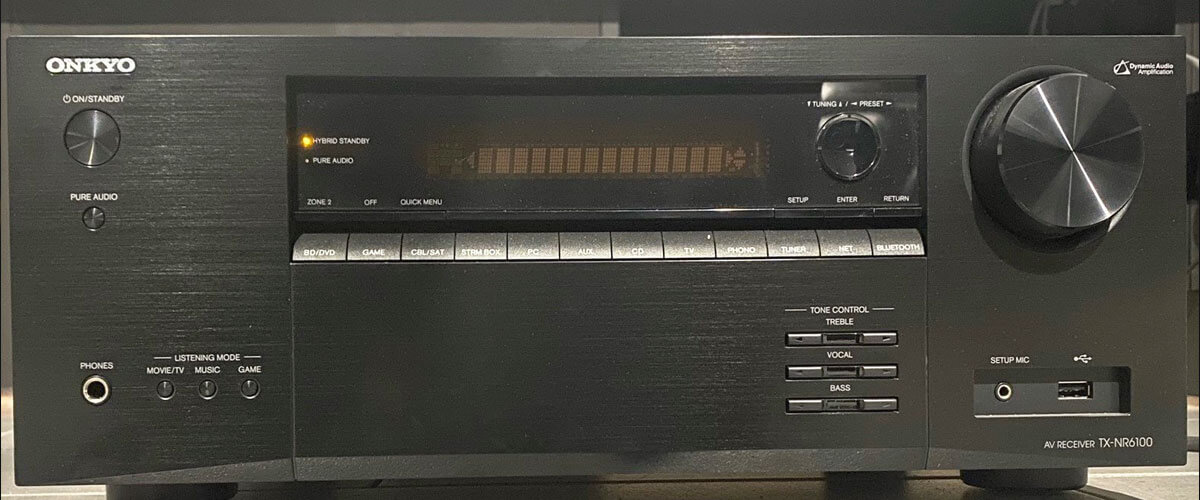
Before you choose a receiver, my advice is to take some time and research your needs and preferences. To simplify this task, I have prepared a set of factors to help you understand exactly what is important to you and what you are willing to pay for. After all, buying any device is ultimately a matter of budget.
How many channels do I need
Choosing between a 5.1, 7.1, or 9.1 channel system comes down to how big of a room you can afford for your home theater. No matter how many channels you choose, the sound should fill the room optimally.
A speaker system of 5 speakers and a subwoofer will work for a small room (about 150 square feet). This is always a budget option, which doesn’t mean it’s bad, as sophisticated listeners can only perceive the difference in sound with a 7.1 system (as well as the difference between the following configurations).
The 7.1 system will provide a more immersive experience. And with it, immersive surround sound formats will be available. But here the optimum space will be 300 square meters and the budget a little higher.
You can truly enjoy the realism of surround sound with 9.1 systems and above. If you have a large house with a huge living room and plenty of space for a large-sized system, you are not afraid of a whole bunch of wires, and your wallet will not be empty from buying all these expensive toys – feel free to choose them.
How many watts per channel do I need
When we think of power, we imagine the scene from Michael Jackson’s “Black or White” music video where the sound of the speaker carries a chair with the father of the family through the roof. Would you want that effect? I don’t think so!
Power alone shouldn’t be the most important factor, but there is a balance, a coherence to the system. You should choose a receiver based on the size of the room (yes, again) and the capabilities of your speakers. Mismatched performance between your speakers and AV receiver can lead to wheezing and the breakdown of the former. Not immediately, but over time, speakers under more pressure than they can handle will simply fail. Usually, the rated power value can be found on the stickers on the technique or in the instructions.
As for the size of the room, it is even simpler. The fact is that the channelization of the receiver determines its power. For example, with a 5-channel receiver, you can get a power of 50-80W, with 7-channel – 80-120, and so on. This is quite appropriate and sufficient for the room for which the AVR is designed.
Determine what you will connect to the receiver
This is probably the most important aspect. But the connectors are actually the easiest to decide on. Count all the appliances you plan to connect to the system and assess how the devices should be connected. The most important port in the receiver is HDMI, as it provides an AV connection for video players and game consoles, and the outputs connect the AVR to TVs or projectors. Try to go for the later 2.0 or 2.1 versions, but some older ones also support eARC and HDCP and will help you keep your signal quality or even improve it.
You may also need a pre-out, subwoofer output, and phono input.
Modern times demand modern facilities, so the availability of Bluetooth and Wi-Fi wireless connectivity is also commendable. They can also vary in versions and provide slightly better or worse streaming.
Extra features
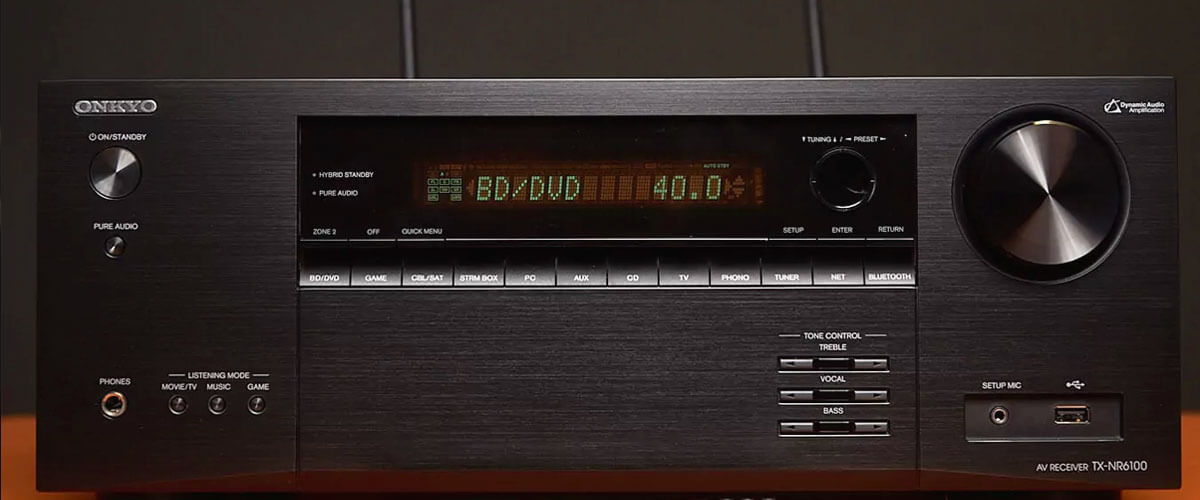
Now let’s take a look at the additional features that will make your audio journey even more exciting.
4K, 8K – visual grandeur
Most receivers today support 4K/120Hz video resolution, but many are moving to support 8K/60Hz. Even among budget models, you can find such models. But not all of them have the scaling function, which is important, in my opinion, because you get a better-quality video on the screen than the one offered by the source.
HDR formats – colorful realism
HDR (high dynamic range) formats are responsible for the contrast level. The better the quality of light transmission, the brighter the objects on your screen. Today there are several versions of these formats: Dolby Vision, HDR10, HDR10+, and HLG, which different companies produce. Just pay attention to the label on your receiver, although most of them support at least two of these formats.
Surround sound formats – Dolby Atmos, DTS:X
While Dolby Digital and DTS HD Master Audio, which are now obsolete, were standard for most people, the immersive formats Dolby Atmos, DTS:X, and Auro-3D are gaining popularity. The first two require a 7.1 configuration, and the third is only available from 9.1 and up. Yes, they are worth it because the viewer feels immersed in the events happening on screen. You hear the sound from where it should be coming from in reality, and that greatly enhances the experience. Especially as more and more content is being released with support for these formats.
Multi-Room – expanding boundaries
The Multi-Room function is suitable for those with a large family with different preferences and enough zones (rooms) to use it. You can broadcast sound from one or more sources to different rooms simultaneously. For example, listen to music in the bedroom or kitchen while your kids watch the same cartoon for the hundredth time in the living room. The more expensive models offer zoning for 3 or even 4 rooms, and the top of them split audio broadcasting and video.
Other functions – crafting your experience
This category includes built-in streaming services, voice assistants, and the availability of smartphone apps to replace the usual remote control that is always getting lost. For example, Denon has the company-developed HEOS, and Yamaha has MusicCast. Research brands and models in detail so you know in advance what options you have with them. Those little bells and bells make it much easier to manage, but they definitely shouldn’t affect your allotted budget for buying an AVR.
We are supported by our audience. When you purchase through links on our site, we may earn an affiliate commission at no extra cost to you.
Our newsletter
* We will never send you spam or share your email with third parties

![Best Budget Receivers [Reviewed and Tested]](https://thetechholics.com/wp-content/uploads/2023/10/best-budget-av-receiver-300x150.jpg)
![Best 9-Channels AV Receivers [Reviewed and Tested]](https://thetechholics.com/wp-content/uploads/2023/10/best-9-2-receiver-300x150.jpg)

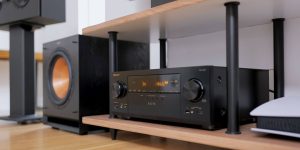
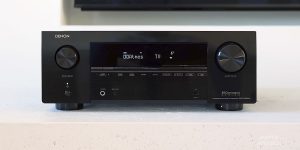
![Pioneer vs Denon Receivers [Top Models Compared and Tested]](https://thetechholics.com/wp-content/uploads/2023/10/denon-vs-pioneer-review-300x150.jpg)
